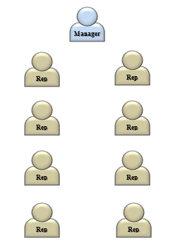The Optimal Sales Manager to Rep Ratio


To the contrary, other organizations have cut back on sales reps due to economic conditions and kept Sales Management in place. Their front-line Sales Leaders have plenty of time to perform key leadership activities, but the impact of overstaffing the Sales Management role is leading to a less efficient sales organization. The money spent on overstaffing Sales Management could be reallocated to other key sales force drivers.
So what is the right number? For a direct sales force, best practice is 8 to 1. Here are 8 factors that can influence the ratio.

- Specialization of Role: Are your sales professionals in a role that is extremely specialized and therefore difficult to learn? This would indicate a tighter span of control may be acceptable. If the role has a short ramp time and can be learned easily, your managers should be able to stretch the ratio.
- Complexity of Sales Process: Transactional / Consultative / Enterprise. Transactional sales cycles are shorter and less complex so they require a smaller amount of training and support. For that reason, Inside Sales Managers may be able to lead a much larger team than 8. Consultative and Enterprise will require more training, support, and development and would therefore require greater management involvement.
- Geographic Span: Typically more time will be spent on travel and dealing with geographic business variations. Sales Managers will have less time for key leadership activities which should result in less direct reports.
- Internal Bureaucracy: How much time do your Sales Managers spend on internal meetings, approvals, and general admin that is self-inflicted?
- Execution of Leadership Fundamental: Do your front-line sales managers spend at least 75% of their time on hiring, training, coaching/development, and motivation? If they do not, they can probably handle more than 8 reps. I don’t recommend this strategy, as the lack of focus on key leadership activities is a less effective approach.
- Tenure: A tenured sales team tends to require less training and development time. Also, Sales Management will spend less time ramping new reps and training on basic product and industry knowledge.
- Sales Rep Leadership: Have you built a culture of player-coaches? If your “A” players help out new or struggling team members, you may be able to use them as an extension of your leadership.
- Support Network: Does HR handle hiring? Do you have sales support to help with administrative tasks? If Product, Service, or Operations Managers help with sales training and coaching you may be able to handle a larger sales team.
Although these factors can influence the optimal sales manager to rep ratio you should still be within the 6:1 to 10:1 range. If it is not, you are either overinvesting in front-line Sales Management or underinvesting in your sales team. What is your current Manager to Rep ratio and what methodology was used to determine it?